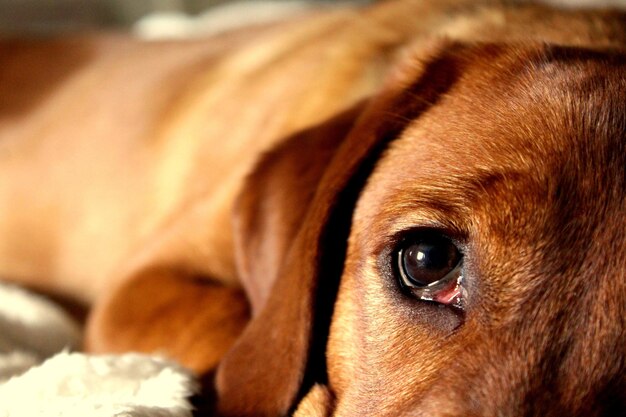Can Dogs Undergo Cataract Surgery? Everything You Need to Know
If you've noticed your dog's eyes looking cloudy or if they're bumping into furniture more often, cataracts might be the culprit. You may be wondering: can dogs actually have cataract surgery like humans? The short answer is yes, but the journey is layered with nuances. In this article, we will delve deeper into whether cataract surgery is an option for your furry friend, examining the ins and outs of the process, what you can expect, and the possible outcomes.
What Are Cataracts in Dogs?
Cataracts are a common eye condition in dogs characterized by the clouding of the lens in the eye, which can impair vision or even lead to blindness. They often appear as a blue, gray, or white discoloration in the dog's eye and can be caused by a variety of factors, including genetics, diabetes, aging, or trauma.
Symptoms of Cataracts
Spotting cataracts can sometimes be as simple as looking your dog in the eyes. Symptoms may include:
- Cloudy or bluish-gray appearance in the eye
- Clumsiness or bumping into objects
- Difficulty finding toys or food
- Hesitancy in unfamiliar surroundings
- Changes in behavior, such as irritability or withdrawal
These signs can be subtle or severe, depending on the progression of the condition.
Canine Cataract Surgery: The Basic Overview
Cataract surgery in dogs mirrors the procedure used for humans, meant to restore vision by removing the cloudy lens. Here's what makes it a viable option for many canine patients.
The Surgical Process
The procedure involves the removal of the cloudy lens and the insertion of an artificial lens. This not only clears the cloudiness but allows light to properly reach the retina, significantly improving vision.
Pre-surgery Examination: A veterinary ophthalmologist will conduct a thorough eye examination and may perform tests like an electroretinogram (ERG) or an ultrasound to evaluate the health of the retina and other parts of the eye.
Surgical Procedure: Conducted under general anesthesia, the surgery usually takes about one to two hours. The surgeon removes the affected lens through a small incision and replaces it with an artificial lens.
Post-operative Care: After surgery, monitoring by a vet is critical. Dogs typically wear an Elizabethan collar to prevent rubbing their eyes and will require multiple follow-up visits.
Success Rates
The majority of dogs regain useful vision after cataract surgery. However, success depends on several factors like overall health, age, and specific eye conditions present alongside cataracts.
Factors to Consider Before Opting for Surgery
While cataract surgery can be life-changing, it involves considerations that are vital for pet owners to understand.
Suitability for Surgery
Not all dogs are suitable candidates. Dogs with severe health issues, such as advanced diabetes or retinal diseases, might not benefit from or be at risk from surgery. Veterinarians typically evaluate the following:
- Overall health
- Age and breed
- Extent of cataract progression
- Underlying conditions like glaucoma
Costs Involved
The costs for cataract surgery in dogs can vary significantly based on geographical location, the complexity of the surgery, and pre/post-operative care requirements. It's typically a substantial investment, making it necessary for pet owners to weigh the costs against the potential benefits.
Risks and Complications
All surgeries carry potential risks. While cataract surgery in dogs is commonly performed and generally safe, possible complications could include:
- Infection
- Surgical failure
- Glaucoma
- Retinal detachment
Alternatives to Surgery
If surgery isn't feasible, there are alternative management strategies.
Non-Surgical Treatments
Though there's no cure to reverse cataracts without surgery, certain treatments may slow progression:
- Antioxidant Eye Drops: These drops are believed to help reduce free radicals that contribute to cataract formation.
- Dietary Changes: A nutrient-rich diet can support overall eye health.
- Monitoring and Managing Diabetes: For diabetic dogs, strict control can slow cataract progression.
Vision Aids
Using obstacles or scents to help your dog navigate their environment more safely can improve their quality of life. Additionally, guiding your dog through voice commands and keeping furniture layouts consistent are beneficial tactics.
Recovery and Life After Cataract Surgery
Understanding what life looks like after the successful completion of surgery is critical to managing expectations.
Post-Surgery Care
The initial few weeks after surgery are crucial for healing. During this time, your dog will require:
- Restricted physical activity to reduce eye strain
- Regular veterinary follow-ups to monitor healing
- Prescription eye drops to aid recovery and prevent infection
Long-term Outlook
Many dogs regain most of their vision post-surgery and enjoy an improved quality of life. However, periodic vet visits are essential to monitor eye health and detect potential issues early.
Key Takeaways for Pet Owners 🐾
- Recognize Early Signs: Early detection is vital. Keep an eye out for changes in vision or behavior that might indicate cataracts.
- Consult a Specialist: Seek advice from a veterinary ophthalmologist to evaluate if your dog is a suitable candidate for surgery.
- Post-Surgery Commitment: Be prepared for the commitment needed in terms of follow-up care and regular monitoring post-surgery.
- Consider Alternatives: If surgery isn’t an option, explore alternative management and support methods to enhance your dog's quality of life.
In conclusion, cataract surgery can be an impactful procedure for dogs suffering from impaired vision. It requires careful consideration, consultation with professionals, and a commitment to post-operative care and follow-up. By understanding the nuances of treatment options, you can make an informed decision that considers both the wellbeing and happiness of your furry companion.
